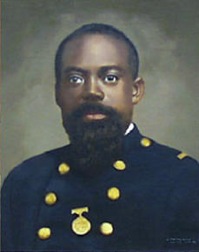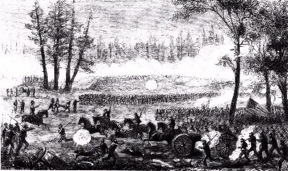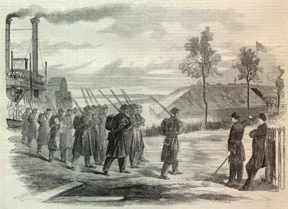The United States Colored Troops: Fighting for Freedom (part one)

At the beginning of the Civil War, black men tried to enlist in both the Union and Confederate armies. Most were not allowed in either army. By the end of the war, though, some 180,000 blacks served in the United States Army, and another 20,000 served in the United States Navy. Approximately 38,000 of them died, most from disease; another 30,000-plus were wounded.
These men were instrumental in helping win the Civil War and freedom for our people.
While there were a few black men in state militias, most states—North and South—banned blacks. However, on May 2, 1861, Louisiana accepted into the state militia a regiment of the Louisiana Native Guard, a group of free black men with black officers, a white commanding officer, and a white officer as second in command. In fact, black men in the Louisiana militia had been a tradition as far back as 1727, although black men in other state militias were rare. The Native Guards were drilled without weapons in the Confederacy, even though they had their own arms.
Both armies used thousands of blacks as servants, teamsters, cooks, and other support positions. Such duties did not qualify them as soldiers. However, there are stories of some men who picked up arms and used them against their enemies.
Some of these men may have joined the armies later in the war once blacks were allowed to enlist. For example, after blacks were allowed in the Confederate army in March of 1865, some of those black soldiers had already served in other capacities for the Confederacy. There were about forty blacks in the integrated companies that left at the fall of Richmond. On the Union side, Sergeant Nimrod Burke of the 23rd USCT started the war as a civilian teamster and scout for the 36th Ohio Volunteer Infantry in April 1861. There were also many slaves who had worked for the Confederates and escaped to the Union army and became USCT soldiers.

Some light-skinned blacks managed to pass themselves of as white and enlisted that way. One example was Lieutenant Colonel William N. Reed of the 1st North Carolina Colored Infantry (later designated the 35th USCT), who was listed as both white and a mulatto. Reed was an abolitionist from New York, but he had graduated from the military school at Kiel, Germany, and served in the German army before coming back to the states. He was very interested in his men, and he helped protect his black doctor, Major John V. DeGrasse, from the prejudices of the white doctors. Reed lead the 1st NC at the Battle of Olustee, where he was killed in action. He is now recognized as the highest-ranking African American in the Civil War by the Military Order of the Loyal Legion of the United States (MOLLUS).
The first black troops in the Civil War were actually enlisted in 1862. They were raised in Kansas, Louisiana, and South Carolina. On July 17,1862, the Second Confiscation Act was approved and subsequently signed by President Lincoln. This act allowed as many persons of African descent as necessary to be “employed to help suppress the rebellion and use them “in such manner” as he may judge best for public welfare.” To some, this meant that they could be used as soldiers.

In Louisiana in July 1862, General John Phelps began to recruit blacks to reinforce his troops outside of New Orleans; General Benjamin Butler could not authorize General Phelps to do this. Phelps resigned. Less than a month later, General Butler, fearing an attack on New Orleans, asked for reinforcements. Being turned down, he organized three regiments of the Louisiana Native Guards. The members of the Guard actually approached Butler first and confirmed their loyalty to the Union on August 15. The Confederates had never used the Native Guard to fight and never armed them, but these men had old muskets of their own. Butler allowed them to keep their black officers: the 1st and 2ndregiments had black captains and lieutenants, while the 3rd had black and white officers. General Butler changed their name to the Corps d’Afrique. Later in the War, their designations would be changed to the 73rd, 74th, 75th USCT.
In Kansas, a paragraph in the Daily Conservative of October 6, 1861, described Senator James H. Lane’s cavalrymen as such:
One peculiarity of this mounted force is curious enough to be noted down. By the side of one doughty and white cavalier rode an erect well-armed and very black man: his figure and bearing were such that, without any other distinguishing characteristic he would still have been a marked man. It is well known that Negroes and Indians serve in the rebel army but this is the first instance which has come to our personal knowledge – although not the only one in fact – of a contraband serving as a Union soldier.
This was the fall of 1861, and Kansas had black soldiers, but they had come through the fighting during the Kansas-Nebraska Act in 1854 up until the Civil War. That Negroes were openly enrolled in the Kansas army should be no surprise because of the radical abolitionism in the Kansas territorial history.
Officially, Lane organized the 1st Kansas Colored Infantry on August 5 with his notification to Secretary of War Edwin Stanton. The next day, he wired Stanton again, stating that he was raising his regiment based on the Second Confiscation Act. The 1st Kansas had the distinction of being the first colored troops to engage the enemy in October 1862 with a raiding party in Missouri. They eventually became the 79th USCT.
In South Carolina, General David Hunter had organized a regiment of former slaves, the 1st South Carolina Colored Infantry, only to have them disbanded because President Lincoln would not approve of Hunter’s emancipation of the slaves in his military district nor authorize the raising of black troops.
While Hunter failed, orders were addressed to General Rufus Saxton on August 25, 1862 to raise 5,000 black soldiers. The 1st South Carolina reformed, and they became the 33rd USCT. The importance of this order was that these soldiers were raised by the authority of the United States War Department and not by some enterprising general on his own authority.
On September 22, 1862, President Lincoln issued the preliminary Emancipation Proclamation to take effect on January 1, 1863. The emancipation freed slaves in the Southern states still in rebellion against the United States. The actual emancipation also allowed for the enrollment of freed slaves into the United States military.

The United States resumed raising troops, and the 54th Massachusetts Infantry Colored was the second regiment raised. They are probably the most famous black regiment because the movie Glory was based on their story. They were authorized in March 1863 by Governor John Andrew; Colonel Robert Gould Shaw served as their commander. Shaw’s parents were abolitionists, as was Shaw and most of the officers. The soldiers were recruited by abolitionists, including Frederick Douglass, who sent his two sons to the 54th. The regiment trained at Camp Meigs in Readville, Massachusetts near Boston and were mustered into service on May 28, 1863.
The 54th is most famous for spearheading the attack on Fort Wagner, at the tip of Charleston harbor, on July 18, 1863. While the 54th and some white units took the outer walls of the fort, they could not take the fort itself. Colonel Shaw and 271 of his men were casualties. Sgt. William H. Carney won the Medal of Honor for grabbing the U.S. flag taking it to the enemy ramparts and bringing it back, even though he was severely wounded.
The 54th fought in two other slightly famous battles, too: the Battle of Olustee and the Battle of Honey Hill. They were also involved in a pay controversy, where white troops were paid $13 a month but black troops were paid only $10 a month, with an additional $3 withheld as a clothing fee, making their pay $7 a month. Massachusetts offered to make up the difference, but to the soldiers, it was the principle of getting equal government pay. On September 28, 1864 pay was equalized by Congress, and they received 18 months pay from the time of their enlistment. Their hold-out controversy affected the entire USCT.
The actual order creating the Bureau of Colored Troops was General Order number 143, issued on May 22, 1863. By the end of the war, 166 regiments of infantry, cavalry, heavy artillery, engineers, and light artillery served and constituted one tenth of the army.
Only four state regiments kept their state designations throughout the war: the 54th Massachusetts Infantry Colored, 55th Massachusetts Infantry Colored, 5th Massachusetts Cavalry Colored, and the 29th Connecticut Infantry Colored. The others all became USCT regiments.
There were some prominent African American recruiters for the Union army, including John Mercer Langston, William Wells Brown, and, of course, Douglass. “Such is the government, fellow citizens, you are now called upon to uphold with your arms,” Douglass said. He continued:
Such is the government that you are called upon to cooperate burying rebellion and slavery in a common grave. Never since the world began was a better chance offered to a long enslaved and oppressed people. The opportunity is given us to be men. With one courageous resolution we may blot out the handwriting of ages against us. Once let the black man get upon his person the brass letters U.S.; let him get an eagle on his button, and a musket on his shoulder, and bullets in his pocket, and there is no power on the earth or under the earth which can deny that he has earned the right of citizenship in the United States. I say again, this is our chance, and woe betide us if we fail to embrace it.
In my next post, I’ll go beyond Fort Wagner to talk about some of the other battles USCT regiments were involved in.
Great to see Steward on board your blog. Steward is a stellar member of the front line staff at F&SNMP, bringing a consistantly enthusiastic approach to every visitor encounter. I look forward to more installments in this series.